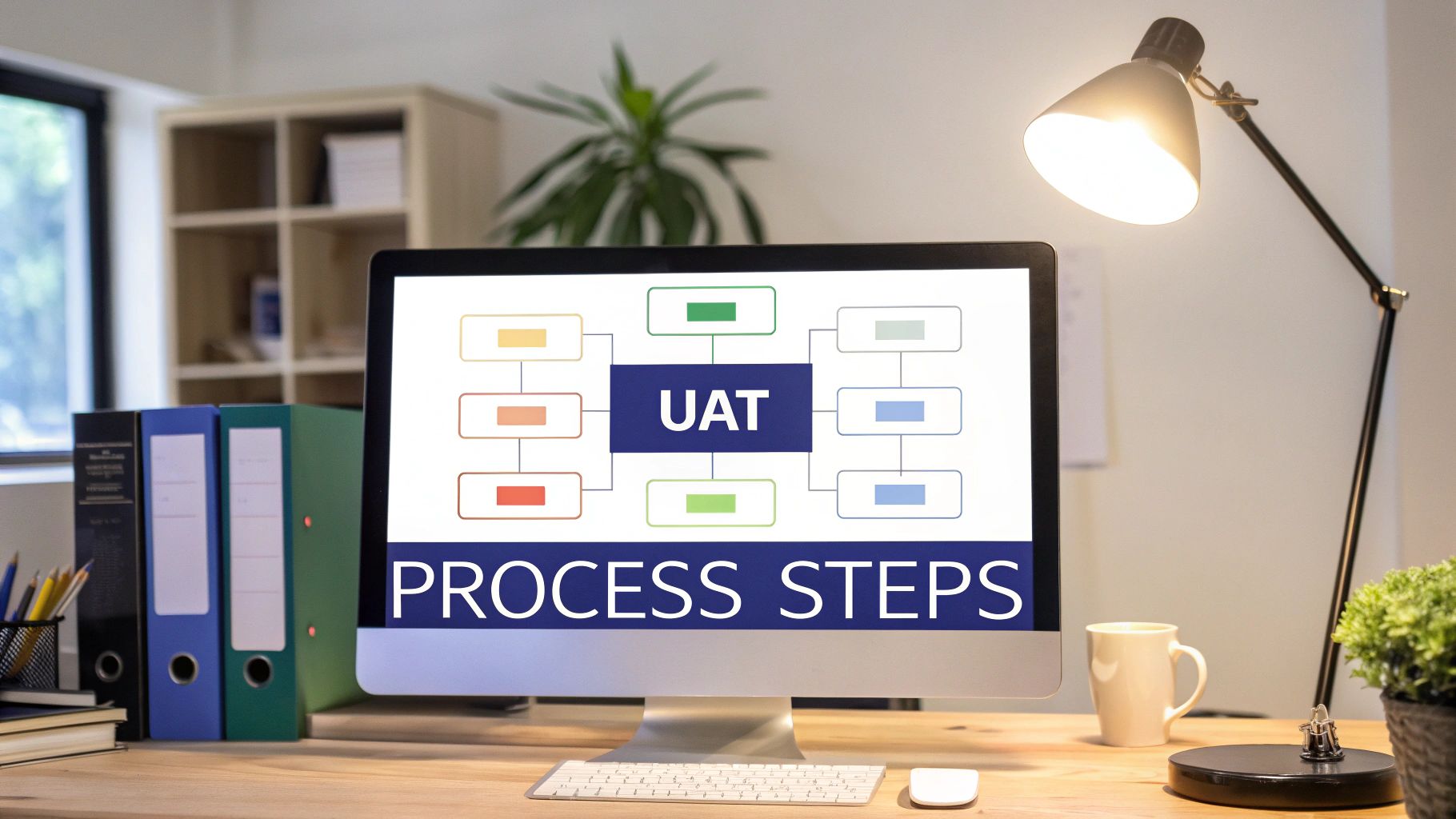Demystifying What Is UAT: Beyond the Buzzwords

What exactly is User Acceptance Testing (UAT)? It's the final testing phase where real users evaluate software to ensure it meets their needs and business requirements. This critical step, executed before any product launch, involves rigorously testing the software in a real-world environment, not just a simulated one. Are you ready to take your software to the next level?
Why Is UAT So Important?
UAT bridges the gap between technical development and practical usage. Developers often prioritize technical specifications. Users, however, focus on functionality and usability. This is where UAT shines. It provides essential feedback, ensuring the software isn't just technically sound but also user-friendly and effective.
Imagine a beautifully designed e-commerce site that's impossible to navigate. UAT would catch this detrimental flaw. This user-centric approach guarantees the software solves the right problems effectively.
UAT also uncovers hidden issues missed in earlier testing. These issues can range from minor usability quirks to major functional problems. Catching these pre-launch saves time, money, and potentially your reputation. Preventing costly post-launch fixes also boosts user satisfaction, which translates to greater success.
Historically, simply assuming a product's readiness was the norm. Today's landscape, however, demands more. Increased user involvement and higher expectations have significantly changed UAT. The focus has shifted to active user feedback throughout the development lifecycle. This evolution underscores the importance of UAT in mitigating potential problems and boosting product acceptance. Want to dive deeper? Discover more insights about UAT from a Business Analyst perspective.
When Does UAT Happen?
UAT typically follows all other testing phases (unit, integration, and system testing). It’s the final checkpoint before deploying the software to end-users, confirming its functionality and real-world readiness. But it’s not a static process.
Leading organizations are constantly adapting UAT to modern Agile and DevOps practices. They're finding ways to integrate user feedback earlier and more continuously. This ensures user validation remains crucial even in fast-paced development cycles. Are you keeping up?
UAT isn't just a box to check; it's a vital investment. It guarantees your software meets user needs and delivers real value. By understanding "what is UAT" and implementing it effectively, you’re setting your software, and your business, up for success.
The Business Case for UAT: Benefits Beyond Bug Hunting

User Acceptance Testing (UAT) is often seen as a final check for bugs before launch. But its true potential goes much deeper. Think of UAT as a strategic investment, minimizing post-launch problems and boosting user satisfaction. This translates into real business advantages, making UAT essential for any successful software project.
Reducing Costs and Risks With UAT
One of the strongest arguments for robust UAT is its power to slash costs. Fixing problems after launch is far more expensive than addressing them during UAT. Imagine a small usability issue found during UAT. It might take a developer a few hours to fix. Now, picture that same issue discovered post-launch. You're looking at potential hotfixes, customer support involvement, and even negative publicity – a far steeper price.
UAT also mitigates risks. A faulty product can severely damage your brand reputation and customer trust. UAT acts as a safety net. Real users validate the software's functionality and usability in a controlled environment before it hits the market. This proactive strategy minimizes the risk of a disastrous launch and safeguards your brand.
Driving User Adoption and Satisfaction
UAT isn't just about avoiding bad outcomes; it's about driving positive ones. By ensuring the software meets user needs, UAT directly contributes to higher user adoption rates. A product that's intuitive, efficient, and solves real problems is much more likely to be embraced by users.
This directly impacts user satisfaction. Satisfied users become loyal customers, recommend your product, and provide valuable feedback. UAT is crucial for boosting user adoption rates and overall efficiency. Investing in UAT improves product quality and provides peace of mind, ensuring your product delivers on its promises. Explore this topic further. You might also be interested in best practices for quality assurance: How to master quality assurance.
Aligning Expectations and Building Confidence
Effective UAT helps align technical teams and business users. It offers a shared platform for feedback and validation, fostering a common understanding of the product. This collaborative process avoids misunderstandings, reduces post-launch surprises, and builds a sense of shared ownership.
Finally, UAT builds confidence. Demonstrating that the software works as intended in real-world use cases reassures the development team, stakeholders, and end-users. This confidence leads to a smoother launch, positive user experiences, and a stronger return on your investment. UAT is not just a testing phase; it’s a strategic investment in your product and your business’s success.
The State of UAT: Revealing Industry Trends and Data

Optimizing your software development lifecycle hinges on a deep understanding of User Acceptance Testing (UAT). It's not just about knowing what UAT is, but how, when, and who is involved. This knowledge unlocks valuable insights into the evolving landscape of UAT and its adaptation to modern development methodologies. Are you ready to unlock the full potential of UAT?
UAT Frequency and Participation
How often do leading organizations conduct UAT, and who participates? These are key questions for benchmarking your own UAT practices against industry leaders and uncovering opportunities for improvement. Simply knowing the definition of UAT isn't enough. You need to understand its practical implementation.
Interestingly, UAT is becoming increasingly integrated into the development process. A significant 34% of organizations perform UAT one or more times per week. Another 32% conduct these crucial tests at least monthly. The importance of direct user feedback is clear, with 40% of respondents consistently involving end-users in their UAT efforts. And while automation is on the rise, manual testing remains a cornerstone, with 86% of respondents relying on it for functional tests.
To better visualize these key statistics, let's take a look at the following table:
UAT Implementation Statistics
| Metric | Percentage | Significance |
|---|---|---|
| Weekly UAT | 34% | Demonstrates a shift towards continuous UAT practices. |
| Monthly UAT | 32% | Indicates regular, if not continuous, UAT integration. |
| End-user involvement | 40% | Highlights the importance of direct user feedback. |
| Manual testing for functional tests | 86% | Shows the continued relevance of manual testing alongside automation. |
These figures highlight the importance and prevalence of UAT. They also underscore the growing trend toward more frequent and user-centric testing practices. Want to delve deeper into these UAT statistics? Find more detailed statistics here.
Manual vs. Automated UAT
The debate between manual and automated UAT continues. While automated testing offers significant efficiency gains, especially for repetitive tasks, manual testing remains crucial. It provides the human touch needed to evaluate user experience, usability, and other qualitative aspects that automated tests simply can’t capture. Finding the right balance between efficiency and a user-centric approach is essential for effective modern UAT.
The optimal strategy often involves a blend of both manual and automated testing. This allows you to harness the strengths of each approach, maximizing both efficiency and the quality of user feedback. The specific mix will depend on various factors, such as project complexity, budget, and timeline.
UAT in Agile and DevOps
The fast-paced nature of Agile and DevOps requires a more streamlined and integrated UAT process. These methodologies emphasize rapid iterations and continuous delivery, demanding a similarly agile approach to UAT.
As a result, organizations are increasingly adopting continuous UAT practices, integrating user feedback earlier and more frequently throughout the development cycle. This shift allows for faster identification and resolution of issues, perfectly aligning with the iterative nature of Agile and DevOps. By embracing continuous UAT, organizations can ensure product quality while maintaining the speed and flexibility these modern methodologies offer.
Industry Variations in UAT
UAT implementation varies significantly across industries. Highly regulated industries, such as finance and healthcare, often have stricter UAT requirements due to the critical nature of their software and the potential impact of errors. Understanding these industry-specific nuances can provide valuable benchmarks as you strive to improve your own UAT effectiveness.
The current state of UAT is dynamic. It’s constantly evolving to meet the challenges and opportunities of modern software development. By staying informed about these trends and adapting your UAT processes accordingly, you can ensure user satisfaction and deliver high-quality products that meet the ever-changing demands of today's market.
Building Your UAT Roadmap: A 5-Step Framework

A well-defined roadmap is essential for successful User Acceptance Testing (UAT). This adaptable framework ensures a structured and efficient UAT process for projects of all sizes and methodologies. It guides you through each stage, from initial planning to final sign-off, maximizing the value of your UAT efforts and ensuring a smooth transition to launch.
Strategic Planning: Defining Scope And Success
The foundation of any successful UAT roadmap is strategic planning. This involves clearly defining the scope of your testing. Outline precisely which features and functionalities will be tested, and establish concrete, measurable success criteria. Without this focused approach, UAT can quickly become unfocused, inefficient, and ultimately ineffective.
Identifying and aligning key stakeholders is equally crucial. A shared understanding of UAT objectives from the outset prevents misunderstandings and ensures everyone works towards the same outcome. This collaborative approach fosters a smoother, more effective UAT process, saving you time and resources in the long run.
Test Scenario Development: User-Focused Test Cases
With a clear scope and aligned objectives, the next step is developing user-focused test cases. These scenarios should mirror real-world user interactions and business requirements. The goal is to simulate how actual users will engage with the software, uncovering potential usability issues and functional gaps before they impact your users.
Detailed, step-by-step instructions within each test case are essential. This precision ensures consistent testing and simplifies the process of identifying the root cause of any problems. It also provides a clear framework for evaluating test results against pre-defined acceptance criteria, ensuring objective and reliable assessment.
Environment Preparation: Ensuring Realistic Conditions
Preparing a realistic testing environment is paramount. This environment should closely resemble the production environment, mirroring data, hardware, and software configurations. A realistic testing environment ensures accurate results, reflecting how the software will perform in real-world usage.
For example, if your software targets mobile devices, testing on a range of actual devices is crucial. This hands-on approach identifies device-specific issues before launch, providing a more accurate and reliable assessment of software performance. This meticulous attention to detail can be the difference between a smooth launch and a post-launch scramble to fix critical issues.
Coordinated Execution: Managing the Testing Process
With the environment prepared, the next step is executing the test cases. This phase requires meticulous coordination of testers, assigning tasks, and diligently tracking progress. Consistent communication and regular updates are vital for maintaining momentum and keeping the UAT process on schedule.
Leveraging a dedicated testing management tool can drastically streamline this process. These tools provide features for task assignment, progress tracking, and automated reporting, enhancing team collaboration and communication. This organized approach ensures a smoother, more efficient, and ultimately, more successful UAT.
Issue Tracking and Resolution: Prioritizing Problems
As testers execute cases, they’ll inevitably uncover issues and bugs. Documenting, prioritizing, and resolving these effectively requires a robust issue tracking system. A well-organized system categorizes issues by severity and impact, allowing for efficient resolution and preventing minor issues from overshadowing critical bugs.
Prioritization is key. Critical bugs blocking core functionalities should take precedence over minor cosmetic issues. This strategic approach maximizes the impact of the UAT effort, ensuring the most critical problems are addressed before release. This proactive approach minimizes disruption and maintains user satisfaction.
Formal Approval Process: Securing Stakeholder Sign-Off
The final stage is the formal approval process. This involves securing sign-off from key stakeholders, confirming the software meets their requirements and is ready for release. This sign-off is a crucial milestone, validating the software’s fitness for purpose and adherence to pre-defined acceptance criteria.
This final step signifies the successful culmination of the UAT process and marks the transition to the next phase of the software development lifecycle. You might be interested in: How to master website quality assurance. This confirmation instills confidence in the software's readiness for deployment.
To understand how UAT fits within the broader testing landscape, let's examine the following comparison:
UAT vs. Other Testing Types: This table compares User Acceptance Testing with other common testing types to highlight their differences and complementary roles.
| Testing Type | Primary Focus | When Performed | Who Performs It | Key Characteristics |
|---|---|---|---|---|
| Unit Testing | Individual components/modules | During development | Developers | Verifies the functionality of individual code units. |
| Integration Testing | Interaction between modules | After unit testing | Developers/Testers | Ensures modules work together seamlessly. |
| System Testing | End-to-end system functionality | After integration testing | Testers | Tests the entire system as a whole. |
| Regression Testing | Impact of changes on existing functionality | After any code change | Testers | Ensures new code doesn't break existing features. |
| User Acceptance Testing (UAT) | Real-world usage and business requirements | Before release | End-users/Stakeholders | Validates the software meets user needs and business objectives. |
This table illustrates how different testing types work together to ensure software quality. While other tests focus on technical aspects, UAT validates the software from a user perspective, ensuring it meets real-world needs and business requirements. This final validation step is critical for successful software implementation and user satisfaction.
Assembling Your UAT Dream Team: Who Does What
User Acceptance Testing (UAT) is a critical phase in any software project. It's the final check to ensure the software meets real-world user needs before it goes live. But UAT isn't a one-person job. It takes a dedicated team with diverse skills and responsibilities to execute effectively. Building the right UAT team is paramount to the success of your software.
Essential UAT Roles and Responsibilities
Effective UAT hinges on a balanced team possessing both technical prowess and a deep understanding of the business needs. Let's examine the crucial roles:
-
Business Analysts: The vital link between business requirements and technical implementation. Business analysts translate user needs into testable scenarios, ensuring the software aligns with business objectives. Their communication skills are essential to keep everyone on the same page.
-
End-Users: The individuals who will ultimately use the software daily. Their hands-on experience provides invaluable feedback, validating the software's usability and practicality. Their input is crucial to ensuring the software truly meets user needs.
-
Product Owners: The champions of user needs and the guardians of the product vision. Product owners ensure the software meets defined requirements and delivers on its promises. They are the ultimate decision-makers when determining if the software is ready for release.
-
QA Specialists: The testing experts who bring rigor and structure to the UAT process. QA specialists design and execute test cases, meticulously identifying and tracking bugs. Their attention to detail helps uncover hidden issues and ensure a comprehensive testing process.
-
Developers: The problem-solvers who address the technical issues identified during UAT. Developers fix bugs, implement changes, and ensure the software's technical soundness. Their involvement in UAT ensures rapid response to any emerging problems.
-
Project Managers: The orchestrators of the entire UAT process. Project managers keep the testing on schedule and within budget. They facilitate communication, manage resources, and ensure the team stays focused on achieving UAT objectives. Their organizational skills are essential for a smooth process.
Building a Balanced and Effective UAT Team
Executive sponsorship is paramount for a successful UAT. This support provides the UAT team with the authority, resources, and recognition they need. It ensures their findings are taken seriously and acted upon, ultimately contributing to the project's success.
A balanced team is essential. You need the technical expertise of your QA specialists and developers, combined with the real-world perspectives of business analysts and end-users. This mix of skills makes for a comprehensive and effective UAT process.
Building a winning UAT team isn’t just about assembling individuals; it’s about creating a collaborative unit. Open communication, collaboration, and a shared understanding of the UAT objectives are key to effective teamwork. By fostering a collaborative environment, you empower your team to deliver high-quality results and ensure your software project is a success.
Overcoming UAT Roadblocks: Solutions That Actually Work
User Acceptance Testing (UAT) is critical for ensuring your software truly meets the needs of your users in real-world scenarios. But even with meticulous planning, roadblocks can emerge. This section explores these common challenges and provides practical solutions to help you navigate them successfully.
Insufficient Time Allocation
One of the most frequent roadblocks is simply not allocating enough time for UAT. Rushing this vital phase can lead to overlooked issues, ultimately compromising the quality of your software. The solution? Secure adequate testing windows early in the project planning process. Communicate the importance of UAT clearly to stakeholders and negotiate realistic deadlines that allow for thorough testing. If time constraints do arise, prioritize critical test scenarios and core functionalities to maximize the impact of your testing efforts within the available timeframe.
Ambiguous Acceptance Criteria
Unclear or ambiguous acceptance criteria can create confusion and hinder effective testing. The key is to define SMART criteria – Specific, Measurable, Achievable, Relevant, and Time-bound. This ensures everyone understands what constitutes a successful test outcome. For example, instead of "the system should be easy to use," define a specific metric such as "users should be able to complete a purchase in under three minutes."
Limited User Availability
Getting enough user participation can be a challenge, especially when your target users have busy schedules. Offer flexible testing options like remote testing or staggered testing windows. Incentivizing participation can also be highly effective. Consider offering gift cards or early access to the software as a thank you for their valuable time and input.
Scope Expansion During Testing
As users interact with the software, they may discover new functionalities or scenarios not initially considered. While valuable, this can lead to scope creep, delaying the project and exceeding your budget. Establish clear boundaries for the UAT scope upfront. If new functionalities emerge during testing, document them and address them in a separate testing phase, maintaining focus and efficiency in your current UAT cycle.
Communication Breakdowns
Communication breakdowns between technical and business teams can derail UAT efforts. Foster open and frequent communication channels between these teams throughout the testing process. Use tools like Slack that allow for real-time feedback and issue tracking, ensuring everyone stays informed and problems are addressed promptly.
Inadequate Test Environments
Testing in an environment that doesn't accurately reflect the production environment can skew your results. Ensure your test environment closely mirrors the production environment in terms of hardware, software, and data configurations. This realistic simulation provides a more accurate assessment of how your software will perform in the real world.
Recovery Tactics for When Things Go Wrong
Even with careful planning, unforeseen issues can still occur during UAT. A contingency plan is essential. This might include fallback options for critical functionalities or alternative testing strategies if your original plan is disrupted. Flexibility and adaptability are key to overcoming unexpected challenges and keeping the UAT process on track.
Ready to streamline your review and feedback process? BugSmash is a comprehensive platform designed to simplify media review and annotation. From websites and videos to PDFs and images, BugSmash centralizes feedback, enhances collaboration, and ensures efficient communication. Try BugSmash today and experience the power of streamlined feedback management. Learn more about BugSmash and how it can benefit your team.




